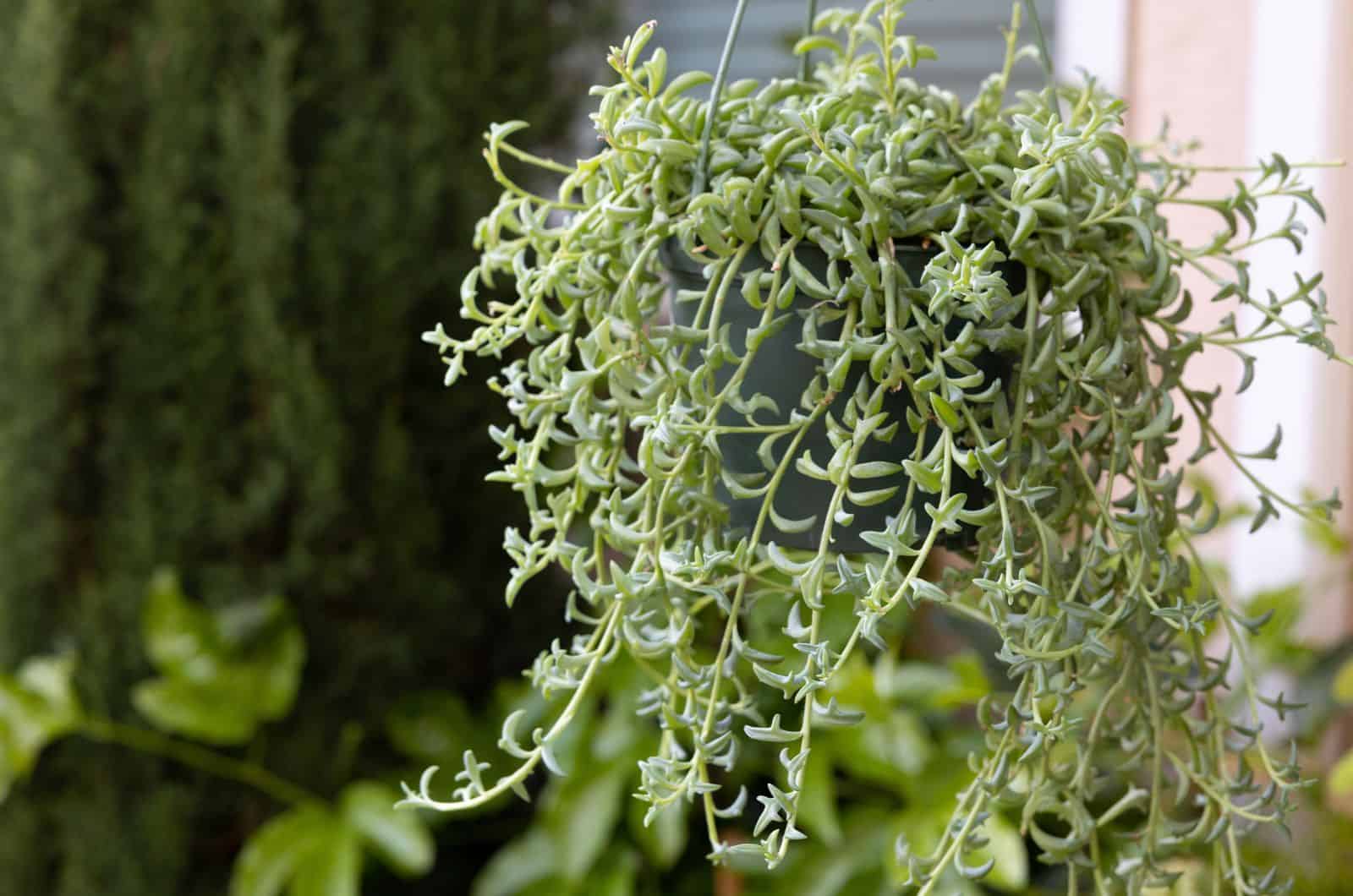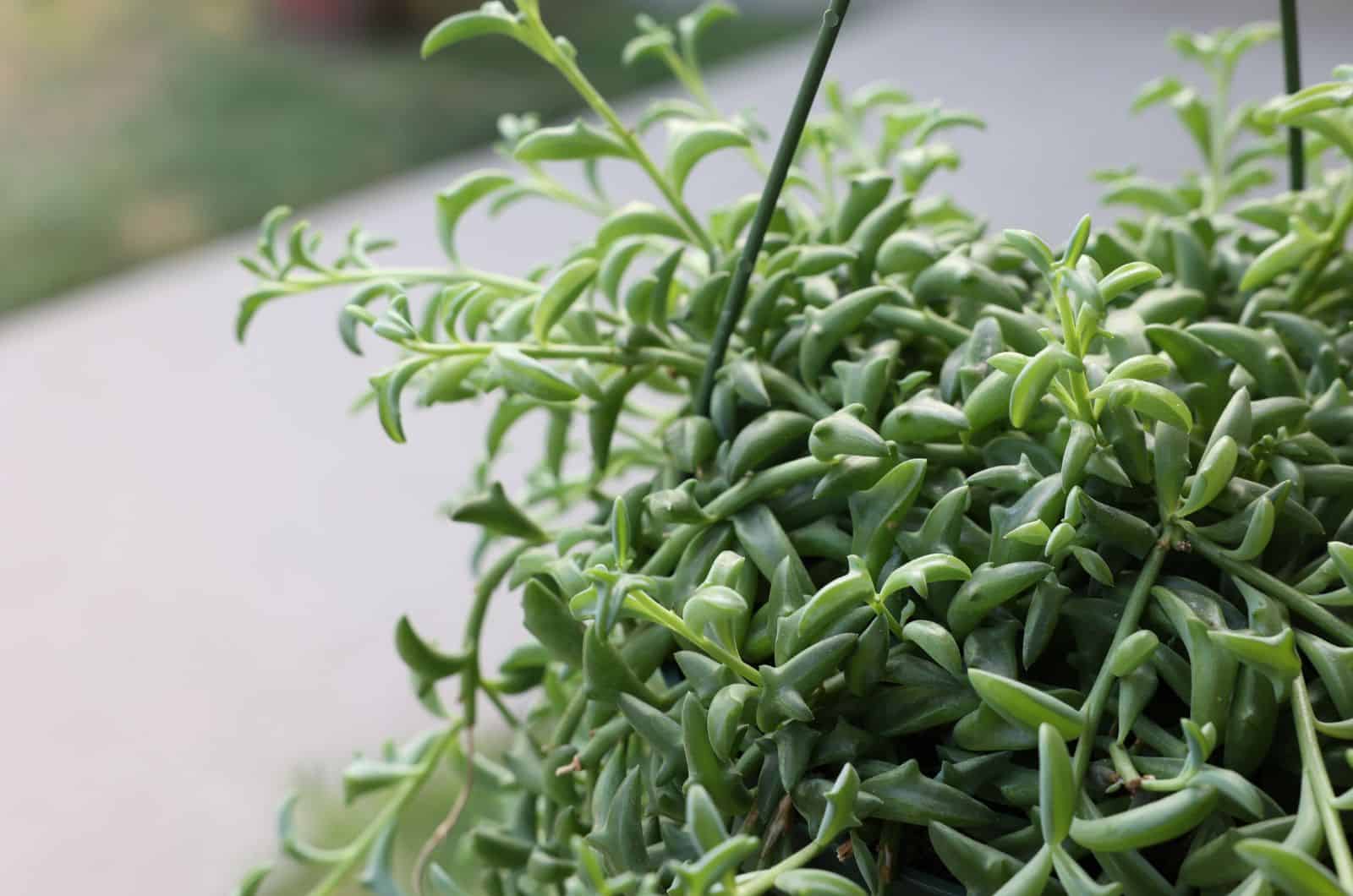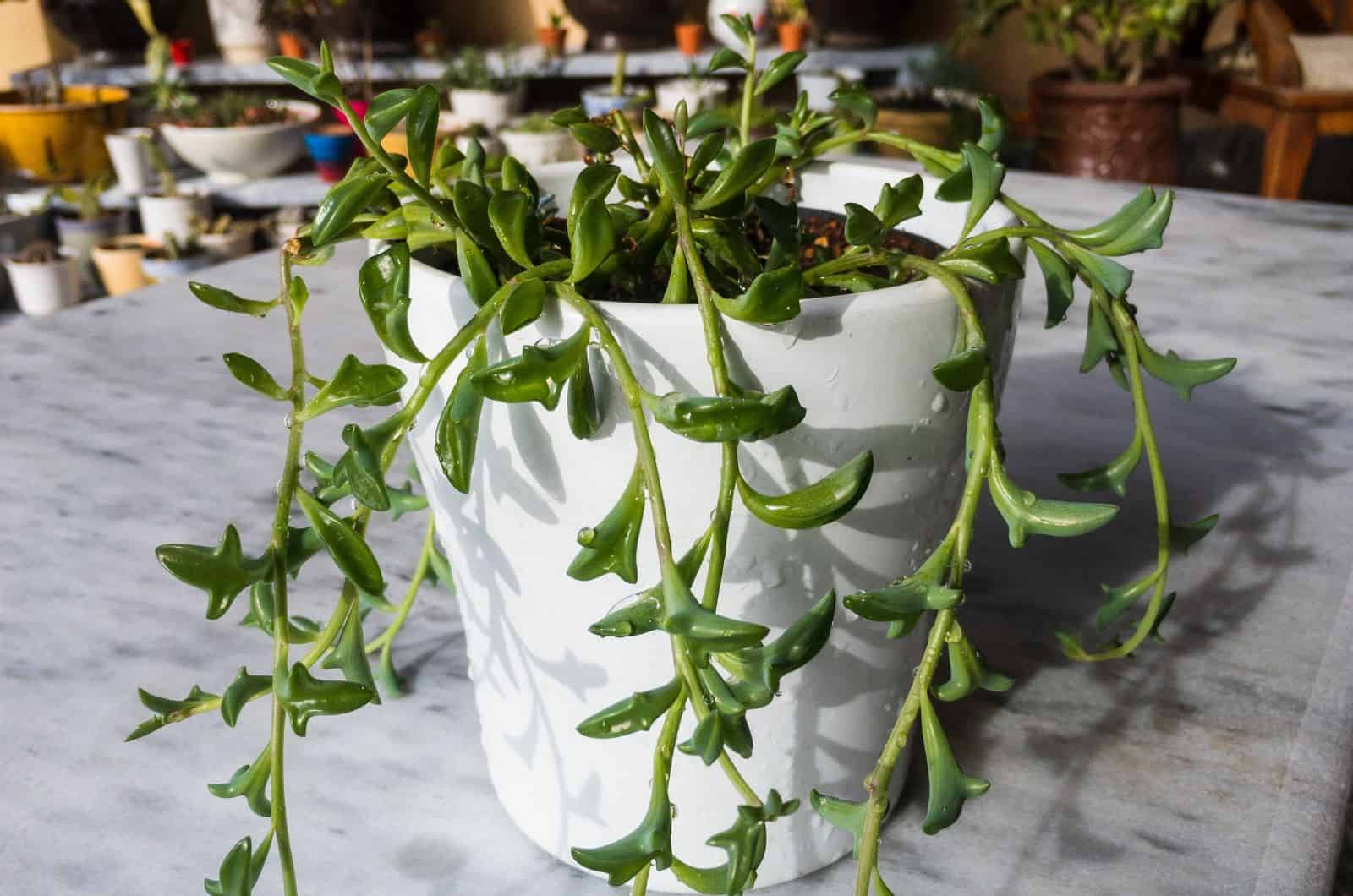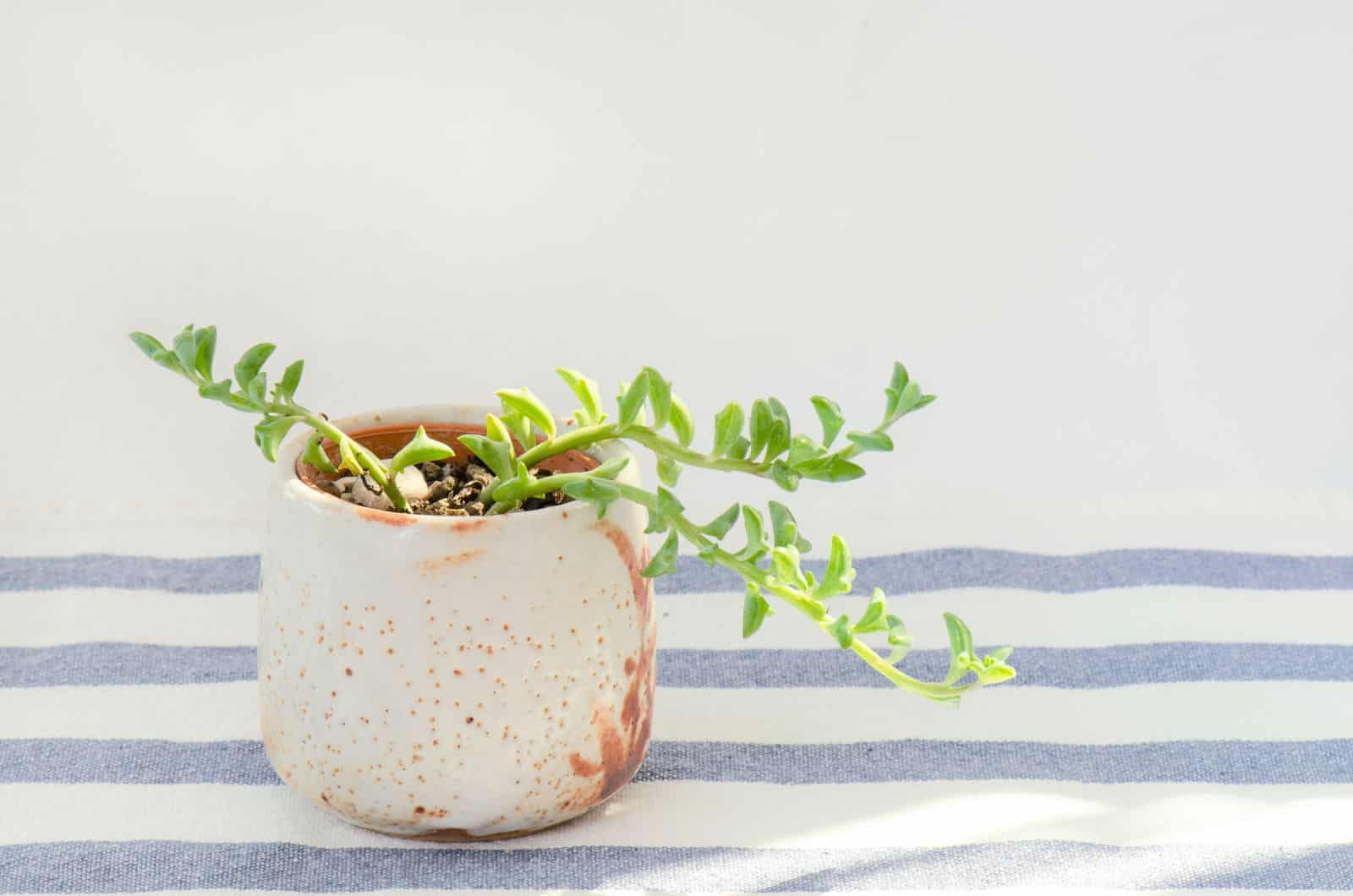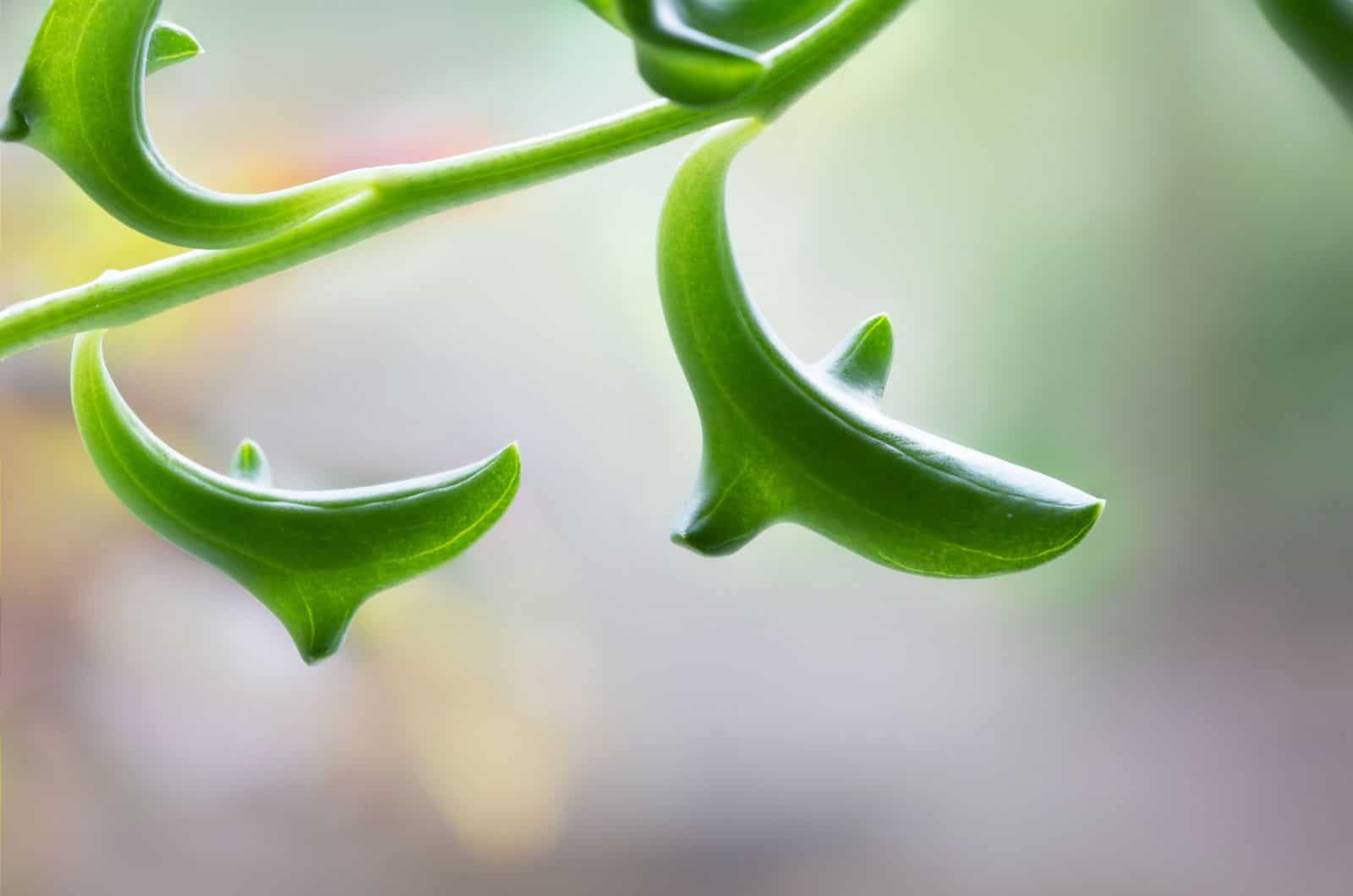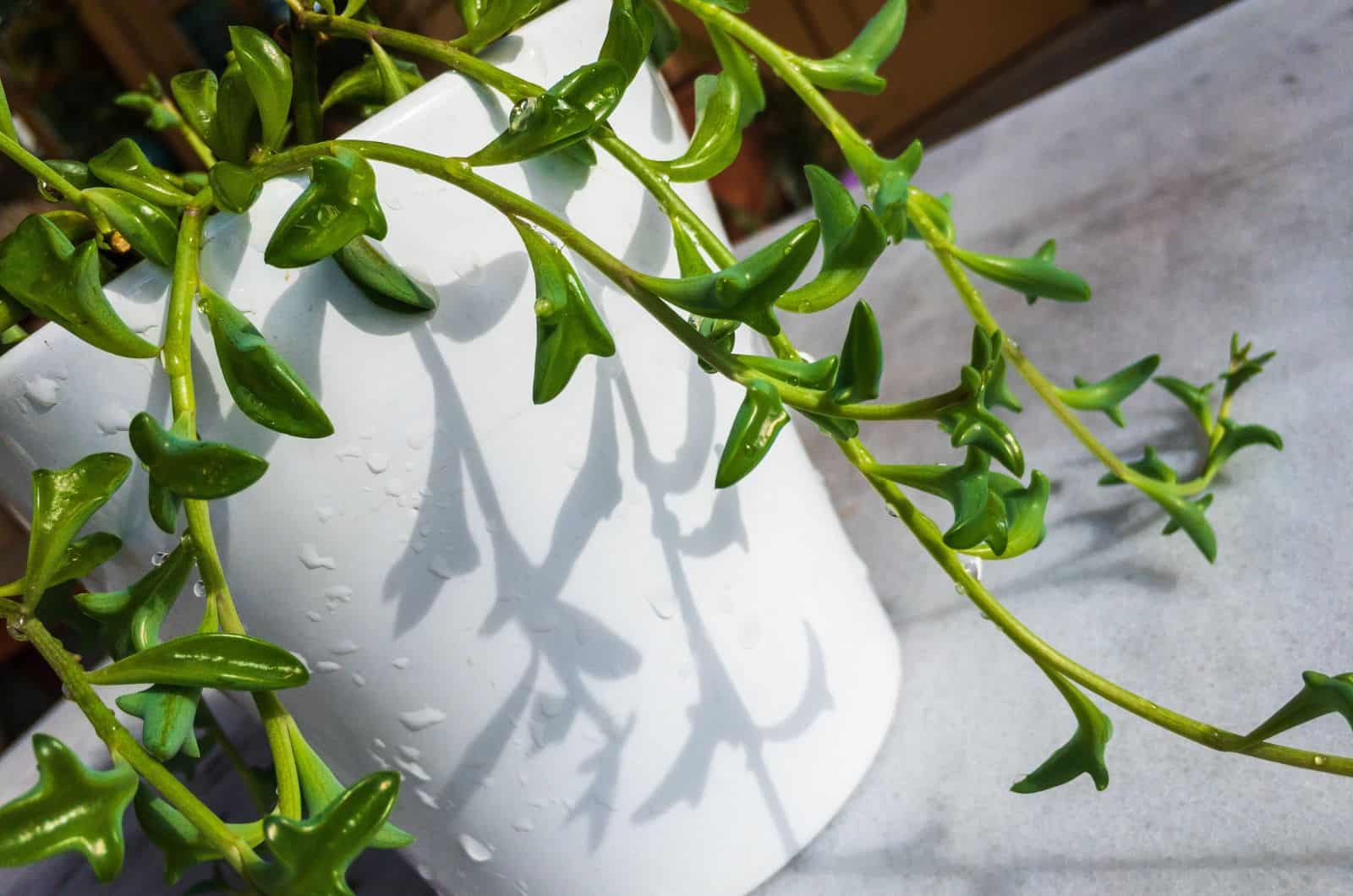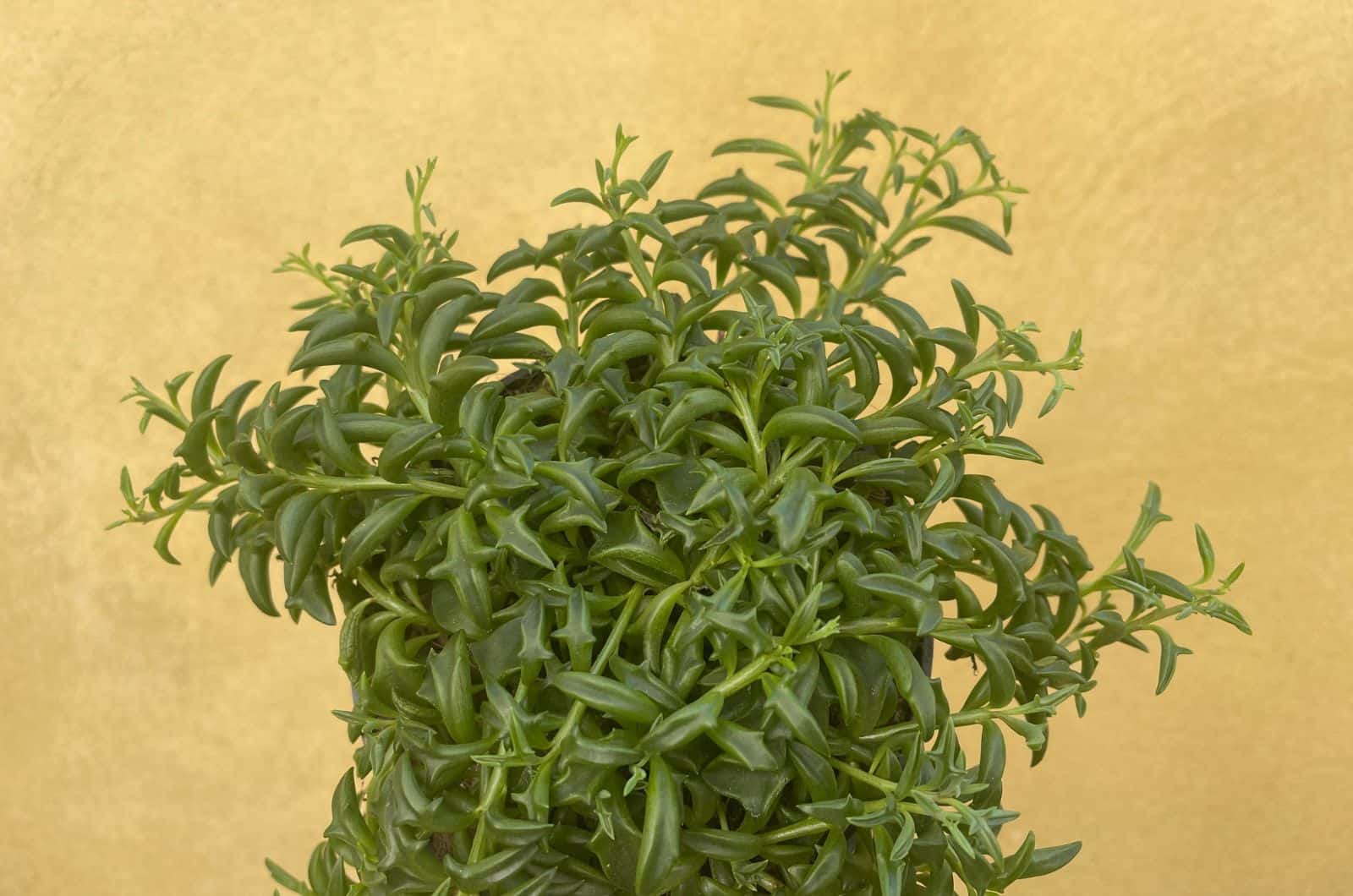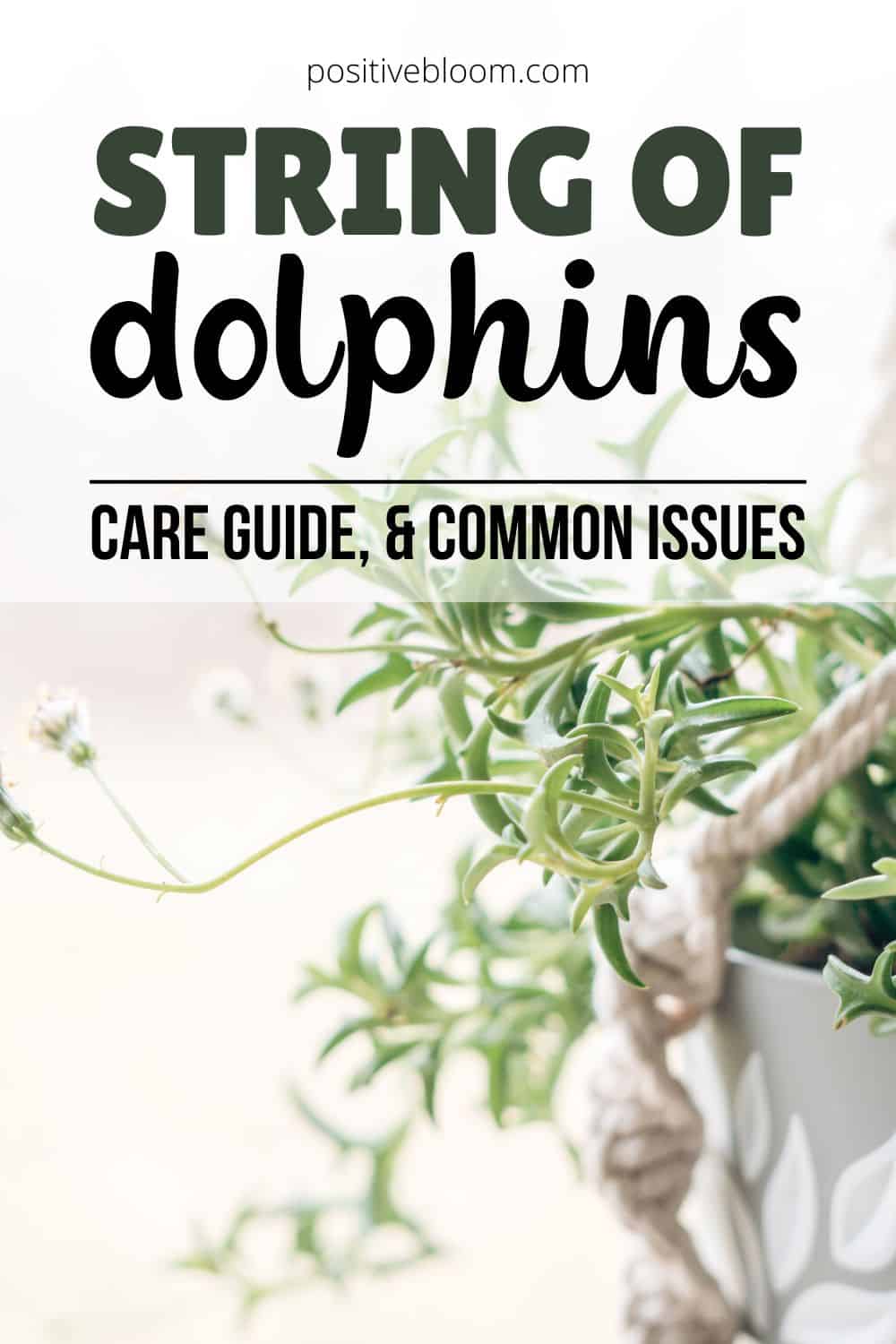Who doesn’t like dolphins? They’re so cute and leave everyone who sees them amazed! What if I told you there’s a plant named after these animals because its leaves bear a resemblance to dolphins?
I’m talking about the string of dolphins, a unique succulent known for its looks and its low-maintenance features.
These plants look incredible in hanging baskets and will thrive with just a little bit of care.
If you decide to grow this beautiful houseplant, you need to know the basics about its growing requirements.
To that end, I will cover every single aspect of string of dolphins plant care. After reading this article, your succulent will be happy and healthy for many years to come!
Let’s first look at some basic info about this plant.
[table id=348 /]
Let’s get started!
What Does The String Of Dolphins Look Like?
What is a string of dolphins plant? To answer that question, let’s first learn more about the dolphin necklace taxonomic features. This plant is a hybrid, and we got it from Senecio rowleyanus, commonly referred to as the string of pearls, and Senecio articulatus, also known as the candle plant or hot dog cactus.
It has to be mentioned that these plants are no longer part of the Senecio genus, but rather belong to the Curio genus. The same re-classification happened to other members of the Asteraceae family, such as the string of bananas and the string of pearls.
This plant is a trailing succulent, and due to its growth habit it has become a very desirable plant. You can help the plant to grow upwards using different supporting structures, such as a moss pole or some alternative.
The dolphin-shaped leaves can climb on structures or the plant can be grown in hanging pots so that the unique leaves cascade downward.
The leaves are light green in color, and have a specific dusty-blue hue that makes the plant even more attractive.
You’ll feel like you are looking at jumping dolphins when you see this plant, so it’s great if you are a sea lover.
The average size of a Senecio peregrinus is 3 feet in width and 6 inches in height.
String Of Dolphins Care Guide
I mentioned the simple care requirements of string of dolphin succulents, but what does that mean?
To start with, here is a table with a quick overview of the string of dolphins care requirements:
[table id=349 /]
Let’s get into details!
How Much Sun Does A String Of Dolphins Need?
The dolphin necklace plant is a sun-loving plant, so you don’t need to be as careful as with other common houseplants when it comes to light.
However, this refers to excess light. Most common houseplants are sensitive to direct sun exposure because too much sun exposure will also affect the dolphin necklace plant, but not as badly as it would affect other plants.
What does this mean? This dolphin-like plant will need approximately 6 hours of bright light each day. You can increase the light exposure, but don’t keep it exposed to full sun for more than 8 hours because you don’t want to burn the fascinating leaves.
On the other hand, low light can cause much bigger health issues for this succulent plant. These plants respond to low light levels by displaying stunted growth, wilting, and paleness.
You should keep your dolphin necklace plant in a south-facing window as it will receive a lot of bright light during the day. However, I put up sheer curtains in case the light is too strong.
West and east-facing windows are also a good choice, but I suggest avoiding north-facing windows due to their low light levels.
If you can’t find any other spot, consider purchasing grow lights to increase the light levels and encourage growth.
Temperature Conditions
You could grow this succulent outdoors, but it largely depends on the temperature range of the area you live in.
Unfortunately, these cute plants aren’t frost-tolerant, so if you live in colder climates you won’t be able to enjoy them in your patio or yard.
Interestingly, these plants won’t die if grown in lower temperatures, but anything lower than 30 degrees Fahrenheit will lead to death.
When grown indoors, these succulents will thrive in average temperatures. Therefore, if it’s comfy for you, it will be comfy for your plant.
However, don’t keep your plant near a fireplace or cold drafts.
Humidity Conditions
Succulents plants’ humidity requirements may be a little tricky to understand. Even though some of these plants will tolerate higher or lower-than-average household humidity, any extremes will cause problems.
Humidity in my home is typical, so it’s around 30%. I know this because I purchased a humidifier on Amazon to monitor and increase humidity if necessary.
I mainly increase humidity levels to ensure a better environment for my tropical houseplants. Your string of dolphins will do just fine in average humidity, but don’t let it go too low or your plant might not grow as fast as it should.
A humidifier isn’t the only way to increase humidity levels; there are some DIY versions, such as a pebble tray and the 2-pots method.
Soil Requirements
When discussing soil requirements for succulent plants, well-draining soil is a must because these plants despise having a lot of water around their roots, and the roots will most likely rot if that does happen.
Therefore, you’ll need a soil mix consisting of materials that aid drainage.
Another requirement when it comes to soil is aeration. Airflow is also essential for healthy root growth, so you’ll need to add materials that improve aeration.
You have two options now – to purchase a ready succulent mix or make a DIY version. I always go with the second one as it’s more fun and I like to be sure of what’s in it.
You can use numerous combinations of materials when making your succulent soil mix, but I’ll mention a few that worked well for my string of dolphins.
The first thing you need is the regular potting soil that you can find at supermarkets. You’ll then need materials that aid drainage and aeration, and for this I recommend perlite, pumice, gardening sand, or orchid bark.
For example, you can make a mixture of 2 parts potting soil, 1 part gardening sand, and 1 part perlite. Another great combination is 2 parts gardening sand, 2 parts potting soil, and 1 part perlite.
Watering Schedule
There are a few things we need to go through when it comes to watering the Senecio peregrinus. First, we need to discuss watering frequency, then watering technique, and finally the type of water.
My favorite feature of this plant is that it’s drought-tolerant. This is especially great for growers who often forget to water their plants.
How Often Should I Water My String Of Dolphins?
The dolphin necklace plant has the ability to store water in its leaves, which means it’ll still have water if you prolong the period between waterings. In other words, the plant is hard to kill.
It would help if you waited until the dolphin plant’s soil is completely dry before giving it a good soak.
There are no strict rules for how much time you must wait to water these succulents. It would be best if you relied on the soil moisture content to decide, so you’ll need to check the moisture before you add water.
The watering needs of this plant will change based on the season. For example, dolphin plant soil will dry out faster during summer, so you’ll need to check on the plant more often during this period.
On the other hand, the dolphin plant enters dormancy during the winter months, so it will need less water.
I will now share more tips about watering these plants.
How To Check Soil Moisture Content
I told you that you should check the soil before you give your dolphin plant a good soak, and I would now like to tell you about the best ways to do so.
Sticking your finger in the soil is the easiest way to check if your dolphin plant needs water. If it feels dry, you can proceed with watering.
If you aren’t sure, check the color of the topsoil; if it’s light brown, the soil is dry.
If you are still worried, lift up the pot, and if it’s lightweight you can add water.
If you aren’t into these methods or you are a beginner, maybe it would be better to purchase a moisture meter to get an accurate measurement before watering your plant.
What Is The Best Water Type?
Although it may seem unnecessary, it’s essential that we go through the best water type for plants because it may be one of the reasons for poor growth or other issues.
This is because tap water, for example, may contain harmful chemicals like chlorine and fluoride, and these may affect the health of your dolphin necklace plant. You should either leave tap water to sit overnight or use other, better types of water.
The best would be if you could use rainwater for your Senecio peregrinus, as that’s the water type it receives in its natural environment.
Honestly, collecting rainwater has made my life much easier because I grow many plants. Alternatively, you can use filtered water. Although it’s not as good as rainwater, it’s definitely a better option than tap water.
What Is The Best Watering Technique?
Many beginner growers think that the only way to water plants is by pouring water on the soil from a watering can.
There’s actually another, way better watering technique that will help you avoid overwatering. You can add water to a sink or in a bucket and place your flying dolphins plant in it.
This technique gives the best results when it comes to absorbing moisture. Your plant will have enough water, and you won’t have to worry about excess water remaining in the soil.
Overwatered vs Underwatered String of Dolphins
Although it seems impossible to underwater this drought-tolerant succulent, it can still happen. This happens most commonly during the growing season and hot summer months.
Luckily, it’s easy to repair damage if your plant displays changes due to a lack of water.
You will be able to recognize that your dolphin plant is underwatered because the soil will be dry, and if you take a portion it will quickly crumble in your hands.
The plant will also start wilting and the dolphin-shaped leaves will start browning.
All you need to do is increase the watering frequency until your plant regains its original glow.
However, an overwatered flying dolphins plant can also give you a hard time. The worst outcome is root rot, and this disease may lead to death if you don’t treat it in time.
There are a few signs of root rot that will warn you that you are overwatering your plant. If you notice that the leaves are yellowing and becoming soft to the touch, you should take your dolphin plant out of the pot and inspect the root system.
Fertilizing Schedule
Another great characteristic of this succulent is that it’s a light feeder. It’s better not to add any food at all than to add too much.
Overfertilization will result in a deformed plant, which means that the unique dolphin-shaped leaves won’t exist!
So, what to do? There are great organic fertilizers that will boost growth. I use fish emulsion or worm castings, and add them at the beginning of the growing season in early spring.
Pruning
Luckily, you don’t need to prune the dolphin plant often, and it’s only strictly necessary if parts of the plant are damaged.
For example, if any leaves are burned, yellow, crispy, or brown, just prune them off and find out what caused the changes. Keep reading to find out more about common problems that affect this plant.
If you want your dolphin plant to grow in a certain direction or you would like to change the shape, you can prune the vines, but please sanitize your tools prior.
Repotting
If you have repotted a string of hearts plant, then you won’t have any issues with the dolphin plant.
The first thing to learn is when to repot this fascinating succulent. This plant will grow well if it’s slightly root bound, which means that you won’t need to repot it too often.
Once it overgrows its pot and the roots are peeking from the drainage holes, you’ll need to change the pot and the soil mix.
Before you start repotting, prepare a new pot that’s slightly larger in size. I recommend terracotta pots with drainage holes. You’ll also need a new potting mix.
Here are the steps for repotting this succulent:
1. Your dolphin plant needs to come out of the pot. Don’t pull it, but rather gently tap on its pot and let the plant slide out.
2. Get rid of the excess soil so that you can clearly see the root system. I mostly use my hands when handling the roots.
3. Untangle the root system to encourage root growth. It may be pretty hard to do this if your dolphin plant is too root-bound. In this case, I recommend using a sharp knife.
4. Add soil mix to the new pot, approximately one-third, and place your dolphin plant in it.
5. Add the remaining soil until you cover the entire root system.
6. Water your flying dolphins plant and resume with usual care.
How To Make The String Of Dolphins Bloom
Although these succulents are primarily grown due to their captivating foliage, they also produce beautiful flowers. I love the scent of the flowers as it reminds me of cinnamon.
If you want to see tiny white blossoms in the early summer, there are a few ways to promote their growth.
You can start in the fall by setting the thermostat to around 60 degrees Fahrenheit.
The next thing is to cut back on watering, and water only when all moisture has evaporated from the soil.
You should also skip fertilization during dormancy and expose your dolphin plant to direct sunlight for 2-3 hours.
Finally, you can let your dolphin plant get slightly rootbound, and don’t rush with repotting.
String Of Dolphins Plant Propagation
Propagation is my favorite part of plant growing. It’s fun and gets me more plants, so I don’t need to go to garden centers and spend money. I also like getting my hands dirty!
String of dolphins propagation isn’t challenging, and with basic knowledge and the right equipment it can succeed almost every time.
The easiest way to get a new dolphin plant succulent is by using stem cuttings. You can root the dolphin plant’s cuttings in water or soil.
Let’s get into details.
Stem Cuttings In Water
Before you start propagating, prepare a sterilized, sharp knife, a new pot, and a transparent jar or vase.
Here are the steps:
1. Select a healthy dolphin plant vine with a few leaves and nodes attached.
2. Take your knife and cut a section where two dolphin-shaped leaves connect.
3. Fill the jar or a similar transparent container with lukewarm water and place the stem cutting in it. Make sure that each cutting has a node immersed.
4. Change the water every two to three days until you notice the dolphin plant stem cuttings have produced roots that are about half an inch long.
You should now put the cuttings in the soil. You’ll find a guide on how to do so below.
Stem Cuttings In Soil
You can also propagate dolphin plants without rooting the cutting in water. The process of taking the stem cuttings is the same.
Instead of placing the cuttings in water, you insert them directly into the soil.
Let’s see how to put the stem cuttings in the soil:
1. Make a small hole in the new soil mix and insert the freshly cut or rooted cutting into the soil. If you are using stem cutting without roots, make sure the node is below the soil line.
2. Gently press the soil down around the dolphin plant cutting so that it stands upright.
3. Put the container in a place with adequate light, temperature, and humidity.
Senecio Peregrinus Succulent: Common Issues
This succulent is truly easy to care for, and you’ll rarely encounter issues.
The main issues are related to common houseplant pests or incorrect conditions.
Let’s learn more.
Pests And Diseases
All growers agree that it’s almost impossible to avoid pests when growing plants. I grow many plants, such as echeverias and peperomias, and pests are often a problem.
Luckily, they won’t cause any serious damage if you spot them in time. The most common annoying creatures that love these dolphin-shaped leaves are mealybugs, spider mites, and aphids.
If you notice these bugs, apply neem oil or insecticidal soap. Remember to inspect your dolphin plant regularly so that you don’t have to deal with a severe pest infestation!
The flying dolphins succulent plant isn’t susceptible to diseases. The disease that can affect it is root rot, which you can easily avoid if you are careful with watering.
Browning And Yellowing
The most common causes of dolphin plant leaf discoloration are overwatering, underwatering, and light issues.
If you notice yellow or brown leaves, check the soil moisture content and light levels.
Leaves Are Losing Their Shape
When I first saw the unique leaves of my dolphin plant were getting flat, I was scared to death.
Believe it or not, this issue is most frequently caused by underwatering, so if it happens just give your dolphin plant a good soak until you see those dolphins jumping again!
FAQs
Is the string of dolphins toxic?
The string of dolphins, scientifically known as Senecio peregrinus, is toxic to cats and dogs. If your pets ingest the leaves they’ll activate the calcium oxalate crystals, which may cause abdominal pain, swelling of the mouth and throat, loss of appetite, and other similar issues.
The best idea would be to keep your dolphin plant out of reach.
Is the string of dolphins rare?
Yes, the dolphin necklace or string of dolphins plant is rare, which is why you should purchase one if you ever see it on the shelves of a plant store. If you already have one, take good care of it because the possibility of finding another one is pretty low.
How fast does a string of dolphins grow?
The dolphin plant grows pretty quickly if provided with the best conditions. You can expect the vines to spread for about 20 inches in the first year. This is an astonishing growth rate considering that the maximum length of the plant’s stem is usually 3 feet.
Therefore, it’s not surprising that this succulent is often seen in vertical gardens.
Wrapping Up
I could talk about the string of dolphins for days as I’m obsessed with its uniquely shaped leaves.However, the appearance isn’t the only thing that makes this succulent so great.
Its ease of care makes it an even more desired plant, so if you come upon one don’t miss the chance!
The only negative is its toxicity, but if you are careful enough and find a spot where your pets can’t reach it, your home will look incredible!
Until next time!
Like this post? Share or pin it for later!

